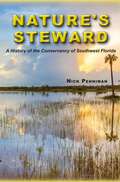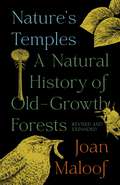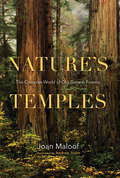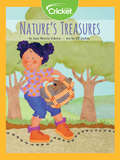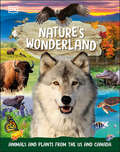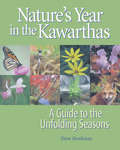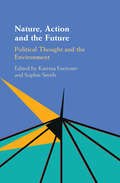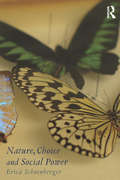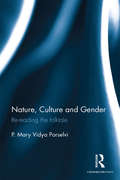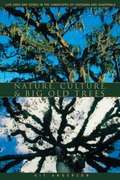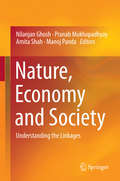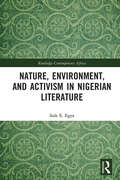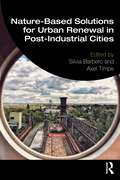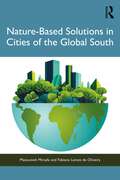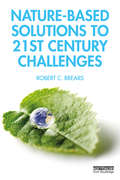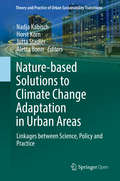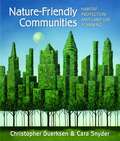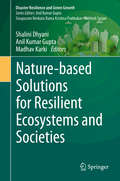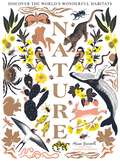- Table View
- List View
Nature's Steward: A History of the Conservancy of Southwest Florida
by Nick PennimanNature's Steward chronicles the development of southwest Florida using the modern-day Conservancy of Southwest Florida as the lens through which to examine environmental history. A parallel track exists alongside the Conservancy's story, and that is the evolution of land acquisition practices and comprehensive growth management planning efforts at the state and federal levels. The reader will come to understand the enormous commitment of time and money required to ensure that a beautiful corner of the world be developed in a generally sensible manner. The book is organized chronologically with three separate topics: land acquisition, managing for growth, and water. Each chapter focuses on events ranging from specific developments like Marco Island to broader initiatives such as the Collier County Rural Lands Stewardship Program, allowing the reader to appreciate the number of years spent working through the nuances, twists, turns, setbacks, and triumphs encountered in steering growth into landscapes best suited for development. This book also intends to sound an alarm. While most development has been carefully directed since the 1970s, water has long been overlooked as a finite resource in building out coastal Collier and Lee Counties. Further inland, extraction industries and creeping urban sprawl are responsible for habitat fragmentation that imperils a dozen threatened and endangered birds and mammals including the iconic Florida panther. And, finally, the prevailing paradigm in Tallahassee has pitched forty years of evolved environmental protection and regulation right out the window. This history of the Conservancy of Southwest Florida attempts to extract meaning from the events of the last fifty years and offers a way of looking at the future. It is the story of southwest Florida, home to a unique ecological system, but it also provides lessons for any other place at risk due to human development.
Nature's Temples: A Natural History of Old-Growth Forests Revised and Expanded
by Joan MaloofAn impassioned case for the importance of ancient forests and their preservationStanding in an old-growth forest, you can instinctively sense the ways it is different from forests shaped by humans. These ancient, undisturbed ecosystems are increasingly rare and largely misunderstood. Nature’s Temples explores the science and alchemy of old-growth forests and makes a compelling case for their protection.Many foresters are proponents of forest management, while ecologists and conservation biologists believe that the healthiest forests are those we leave alone. Joan Maloof brings together the scientific data we have about old-growth forests, drawing on diverse fields of study to explain the ecological differences among forests of various ages. She describes the life forms and relationships that make old-growth forests unique—from salamanders and micro-snails to plants that communicate through fungi—and reveals why human attempts to manage forests can never replicate nature’s sublime handiwork. This revised and expanded edition also sheds new light on the special role forests play in removing carbon from the atmosphere and shares what we know about the interplay between wildfires and ancient forests.With drawings by Andrew Joslin that illustrate scientific concepts and capture the remarkable beauty of ancient trees, Nature’s Temples invites you to discover the power of these fragile realms that are so inextricably connected to our planet, our fellow species, and our spirits.
Nature's Temples: The Complex World of Old-Growth Forests
by Joan Maloof“Maloof eloquently urges us to cherish the wildness of what little old-growth woodlands we have left. . . . Not only are they home to the richest diversity of creatures, but they work hard for humans too.” —New York Times Book Review An old-growth forest is one that has formed naturally over a long period of time with little or no disturbance from humankind. They are increasingly rare and largely misunderstood. In Nature’s Temples, Joan Maloof, the director of the Old-Growth Forest Network, makes a heartfelt and passionate case for their importance. This evocative and accessible narrative defines old-growth and provides a brief history of forests. It offers a rare view into how the life-forms in an ancient, undisturbed forest—including not only its majestic trees but also its insects, plant life, fungi, and mammals—differ from the life-forms in a forest manipulated by humans. What emerges is a portrait of a beautiful, intricate, and fragile ecosystem that now exists only in scattered fragments. Black-and-white illustrations by Andrew Joslin help clarify scientific concepts and capture the beauty of ancient trees.
Nature's Treasures
by Jane Morris UdovicA young girl learns about the wonders of nature in this rhyming poem.
Nature's Trust
by Mary Christina WoodEnvironmental law has failed in its most basic purpose. Even as ecosystems collapse across the globe and climate crisis intensifies, environmental agencies worldwide use their authority to permit the very harm that statutes were passed to prevent. This book exposes the dysfunction of environmental law and offers a transformative approach based on the public trust doctrine. An ancient and enduring principle, the public trust doctrine empowers citizens to protect their inalienable property rights to crucial resources. It holds government to a fiduciary obligation to protect such natural assets as generational inheritance for all citizens. Although the public trust has long offered a theoretical ideal for environmental law, until now it has lacked the precision necessary for citizens, government employees, legislators, educators, and judges to apply it to a broad realm of issues. This book shows how a trust principle can apply from the local to global level to protect the planet.
Nature's Wealth
by Pieter J. H. van Beukering Elissaios Papyrakis Jetske Bouma Roy Brouwer Pieter J. H. van Beukering Elissaios Papyrakis Jetske BoumaIncreasing pressure from economic development and population growth has resulted in the degradation of ecosystems around the world and the loss of the essential services that they provide. Understanding the linkages between ecosystem service provisioning and human well-being is crucial for the establishment of effective environmental and economic development policy. Presenting new insights into the relationship between ecosystem services and livelihoods in developing countries, this book takes up the challenge of assessing these links to demonstrate their importance in policy development. It pays special attention to innovative management opportunities that improve local livelihoods and alleviate poverty while enhancing ecosystem protection. Based on eighteen studies in more than twenty developing countries, the authors explore the role of biodiversity-, marine-, forest-, water- and land-related ecosystem services, making this an invaluable contribution to research on the role of ecosystems in supporting the livelihoods of the poor around the world.
Nature's Wonderland: Animals and Plants from the US and Canada
by DKGo on a thrilling adventure and discover the amazing natural landmarks and diverse wildlife of Canada and the USA. There&’s nowhere on Earth like North America… From scorching deserts to frozen tundra, dense rainforests to coral reefs—this continent has it all! In this captivating nature book, children can take a tour of the most amazing environments across Canada and the US, the two biggest countries in North America.Children aged 7-9 can learn all about incredible natural features like Niagara Falls — and find out which North American waterfall is actually higher! Get to know the unique animals that live only in southern Florida. Find out which species can survive in Death Valley, the hottest place in the world. Full of amazing photographs and charming illustrations, this fascinating nature book is your ultimate guide to the amazing natural wonders, wildlife, and environments of Canada and the USA.This educational book for wildlife lovers features:- More than 200 entries on incredible natural landmarks, plants, and animals from across the USA and Canada- Beautiful illustrations, stunning photography, and engaging text are combined to make dynamic, scrapbook-style collage pages- Chapters each split into broad regions such as western USA, with pages that focus on significant sub-regions within the area, such as the Pacific Northwest and the Rocky Mountain- 30 feature pages that go into detail on key natural features across the regionNature&’s Wonderland is the perfect book for children who are fascinated by nature and curious about North America&’s habitats! With engaging information and absorbing photography, this book is perfect for children to explore by themselves or with an equally curious adult.
Nature's Year in the Kawarthas: A Guide to the Unfolding Seasons
by Drew Monkman Kimberly CaldwellNature’s Year in the Kawarthas is an almanac of key events occurring in the natural world over the course of a year in the Kawartha Lakes district – and in cottage country in general. Covering all areas of our flora and fauna as well as weather and the night sky, the book is a month-by-month chronicle of the mileposts of the passing seasons. From the raucous Spring Peeper chorus of April … through the sweet scent of milkweed blossoms in July … and the early-morning mists of September … to the arrival of the first eagles in December – all are noted for your interest. Whenever you head out on your next walk or look up at the stars, Nature’s Year will be your informative guide. For each month, an introductory essay captures the spirit of the season, while an "at a glance" summary lists the key natural events occurring. Each category in the natural world – from birds to the night sky – is then covered in more detail. Finely detailed drawings complement the text. Author Drew Monkman is a teacher in Peterborough, Ontario. An avid naturalist in the Kawartha Lakes area, he is past president of the Peterborough Field Naturalists.
Nature's Year: Changing Seasons in Central and Eastern Ontario
by Drew MonkmanWhatever your interest may be, this month-by-month guide to the key natural events in Central and Eastern Ontario will let you know exactly what’s happening — and it’s often in your own backyard. Nature’s Year is an almanac of key events in nature occurring in Central and Eastern Ontario, a region that extends from the Bruce Peninsula and Georgian Bay in the west to Ottawa and Cornwall in the east. The book is a chronicle of the passing seasons designed to inform cottagers, gardeners, photographers, suburban backyard birders, and nature enthusiasts alike as to what events in nature to expect each month of the year. Whatever your interest may be – birds, mammals, amphibians, reptiles, fish, invertebrates, plants, fungi, weather, or the night sky just turn to a given month and you’ll find a list of what’s happening, often right in your own backyard. This book will also provide a reassuring measure of order and predictability to nature and help the reader become more attentive to and appreciative of the many wonders of the natural world that surround us in this exceptional region of Ontario.
Nature, Action and the Future: Political Thought and the Environment
by Katrina Forrester Sophie SmithClimate change is one of the great challenges of modern politics. In this volume, leading political theorists and historians investigate how the history of political ideas can help us make sense of it. The contributors add a historical perspective to contemporary debates in political theory. They also show that the history of political thought offers new directions for thinking about the environment today. By situating the relationship between humans and nature within a wider history of ideas, the essays provide alternative ways of thinking about the most intractable problems of environmental politics - the status of science in modern democracies, problems of collective action, and the challenges of fatalism. This volume will create new avenues of research for scholars and students in the history of political thought. It is essential reading for undergraduate students interested in environmental challenges: both those in politics seeking a historical perspective, and those in history who want to link their studies to the present.
Nature, Choice and Social Power
by Erica SchoenbergerWe are at an environmental impasse. Many blame our personal choices about the things we consume and the way we live. This is only part of the problem. Different forms of social power - political, economic and ideological - structure the choices we have available. This book analyses how we make social and environmental history and why we end up where we do. Using case studies from different environmental domains – earth and water, air and fire – Nature, Choice and Social Power examines the form that social power takes and how it can harm the environment and hinder our efforts to act in our own best interests. The case studies challenge conventional wisdoms about why gold is valuable, why the internal combustion engine triumphed, and when and why suburbs sprawled. The book shows how the power of individuals, the power of classes, the power of the market and the power of the state at different times and in different ways were critical to setting us on a path to environmental degradation. It also challenges conventional wisdoms about what we need to do now. Rather than reducing consumption and shrinking from outcomes we don’t want, it proposes growing towards outcomes we do want. We invested massive resources in creating our problems; it will take equally large investments to fix them. Written in a clear and engaging style, the book is underpinned with a political economy framework and addresses how we should understand our responsibility to the environment and to each other as individuals within a large and impersonal system.
Nature, Culture and Gender: Re-reading the folktale
by P. Mary PorselviFolktales in India have been told, heard, read and celebrated for many centuries. In breaking new ground, Indian folktales have been reread and examined in the light of the Mother Earth discourse as it manifests in the lifeworlds of women, nature and language. The book introduces ecofeminist criticism and situates it within an innovative folktale typology to connect women and environment through folklore. The book proposes an innovative paradigm inspired by the beehive to analyze motifs, relationships, concerns, worldviews and consciousness of indigenous women and men who live close to nature as well as other socially marginalized groups. In the current global context fraught with challenges for ecology and hopes for sustainable development, this book with its interdisciplinary approach will interest scholars and researchers of literature, environmental studies, gender studies and cultural anthropology.
Nature, Culture, and Big Old Trees: Live Oaks and Ceibas in the Landscapes of Louisiana and Guatemala
by Kit AndersonBig old trees inspire our respect and even affection. The poet Walt Whitman celebrated a Louisiana live oak that was solitary "in a wide flat space, / Uttering joyous leaves all its life without a friend a lover near. " Groves and alleys of live oaks remain as distinctive landscape features on Louisiana's antebellum plantations, while massive individuals still cast their shade over churches, graveyards, parks, and roads. Cajuns have adopted the "Evangeline Oak" as one of their symbols. And the attachment that Louisianians feel for live oaks is equaled by that of Guatemalans for ceibas, the national tree of Guatemala. Long before Europeans came to the Americas, the ceiba, tallest of all native species, was the Mayan world tree, the center of the universe. Today, many ceibas remain as centers of Guatemalan towns, spreading their branches over the central plaza and marketplace. In this compelling book, Kit Anderson creates a vibrant portrait of the relationship between people and trees in Louisiana and Guatemala. Traveling in both regions, she examined and photographed many old live oaks and ceibas and collected the stories and symbolism that have grown up around them. She describes who planted the trees and why, how the trees have survived through many human generations, and the rich meanings they hold for people today. Anderson also recounts the natural history of live oaks and ceibas to show what human use of the landscape has meant for the trees. This broad perspective, blending cultural geography and natural history, adds a new dimension to our understanding of how big old trees and the places they help create become deeply meaningful, even sacred, for human beings.
Nature, Economy and Society
by Nilanjan Ghosh Pranab Mukhopadhyay Amita Shah Manoj PandaThis book presents an enquiry into the interface between nature, economy and society, which is still in its early stages, notwithstanding the commendable progress and advances made in the field of environmental and natural resource economics within the ever-expanding boundaries of economics as a discipline. It further delineates the evolution of an inter-disciplinary framework for analyzing the status, the future goals, mechanisms and policy instruments that can help move towards a more ecologically sustainable, economically beneficial and socially just future. A pre-requisite for preparing a comprehensive and coherent framework involves unfolding the multiple layers of interconnectedness between the three systems nature, economy and society, each of which has its own internal consistencies as well as externalities. Against this backdrop, the book presents scholarly contributions that focus on four broadly defined building blocks, namely: i) accounting for ecosystems services for life and human well-being; ii) impacts of economic growth on ecosystems; iii) social norms, equity, and governance; and iv) alternative approaches to green and socio-economic systems. The analyses, presented by some of the most eminent national and international scholars, address the major environmental challenges that nations around the world face today and consider which specific policy directions at the international and national level are needed. In particular, the choices India and South Asia now face, as development and environment both need to be addressed adequately, touch on many of these challenges.
Nature, Environment and Poetry: Ecocriticism and the poetics of Seamus Heaney and Ted Hughes (Routledge Environmental Humanities)
by Susanna LidströmThe environmental challenges facing humanity in the twenty-first century are not only acute and grave, they are also unprecedented in kind, complexity and scope. Nonetheless, or therefore, the political response to problems such as climate change, biodiversity loss and widespread pollution continues to fall short. To address these challenges it seems clear that we need new ways of thinking about the relationship between humans and nature, local and global, and past, present and future. One place to look for such new ideas is in poetry, designed to contain multiple levels of meaning at once, challenge the imagination, and evoke responses that are based on something more than scientific consensus and rationale. <P><P> This ecocritical book traces the environmental sensibilities of two Anglophone poets; Nobel Prize-winner Seamus Heaney (1939-2013), and British Poet Laureate Ted Hughes (1930-1998). Drawing on recent and multifarious developments in ecocritical theory, it examines how Hughes's and Heaney's respective poetics interact with late twentieth century developments in environmental thought, focusing in particular on ideas about ecology and environment in relation to religion, time, technology, colonialism, semiotics, and globalisation. <P><P> This book is aimed at students of literature and environment, the relationship between poetry and environmental humanities, and the poetry of Ted Hughes or Seamus Heaney
Nature, Environment, and Activism in Nigerian Literature (Routledge Contemporary Africa)
by Sule E. EgyaNature, Environment, and Activism in Nigerian Literature is a critical study of environmental writing, covering a range of genres and generations of writers in Nigeria. With a sustained concentration on the Nigerian experience in postcolonial ecocriticism, the book pays attention to textual strategies as well as distinctive historicity at the heart of the ecological force in contemporary writing. Focusing on nature, the environment, and activism, the author decentres African ecocriticism, affirming the eco-social vision that differentiates environmental writing in Nigeria from those of other nations on the continent. The book demonstrates how Nigerian writers, beyond connecting themselves to the natures of their communities, respond to ecological problems through indigenous literary instrumentalism. Anchored on the analytical concepts of nature, environment, and activism, the study is definitive in foregrounding the contribution of Nigerian writing to studies in ecocriticism at continental and global levels. This book will be of interest to scholars of African and Postcolonial literature, ecocriticism, and the environmental humanities.
Nature, Place, and Story: Rethinking Historic Sites in Canada (McGill-Queen's Rural, Wildland, and Resource Studies #8)
by Claire CampbellImagining how prominent national historic sites might confront critical issues in environmental history.
Nature-Based Solutions for Urban Renewal in Post-Industrial Cities
by Silvia Barbero Axel TimpeThis book, based on the experiences and insights gained during the Horizon 2020 project proGIreg, offers a detailed overview of targeted nature-based solutions and their impacts on various key sustainability areas, guiding readers through the spatial analysis, co-design, and implementation processes of cities in Europe and Asia. Chapters shed light on the challenges and opportunities encountered in each location, including Germany, Italy, Croatia, Bosnia and Herzegovina, Greece, Portugal, Romania and China. It also shares essential lessons learned and a wide range of indicators crucial for assessing the benefits of nature-based solutions on social innovation, circular economy, biodiversity, and health. Finally, the focus of this book shifts to the future of nature-based solutions as catalysts for new and green community economies as well as policies aimed at addressing climate change and urban renewal. The lessons and insights from the projects highlighted in this book will be valuable for urban planners and policymakers worldwide, as well as for a broader audience interested in nature-based solutions and urban regeneration.The Open Access version of this book, available at www.taylorfrancis.com, has been made available under a Creative Commons CC-BY 4.0 license.
Nature-Based Solutions in Cities of the Global South
by Masoumeh Mirsafa Fabiano Lemes de OliveiraThis book explores the practice of Nature-Based Solutions (NBS) in the cities of the Global South. NBS are recognized as a key strategy for achieving sustainable development, and they are being implemented in a variety of sectors such as urban planning, agriculture, forestry, and water management. They offer a wide range of benefits, but there is a gap between research and practice across cities from the Global South. This book promotes implemented urban NBS projects in the Global South to help identify region-specific challenges and opportunities, and to develop more effective and equitable solutions. The presented case studies support resilient planning in the Global South and significantly inform urban debates in the Global North. This book offers pragmatic policy and planning recommendations, providing decision-makers with clear guidance on implementing NBS in urban settings and transforming knowledge into actionable strategies for sustainable and resilient urban development.
Nature-Based Solutions to 21st Century Challenges
by Robert C. BrearsThis book provides a systematic review of nature-based solutions and their potential to address current environmental challenges. In the 21st century, society is faced by rapid urbanisation and population growth, degradation and loss of natural capital and associated ecosystem services, an increase in natural disaster risks, and climate change. With growing recognition of the need to work with ecosystems to resolve these issues there is now a move towards nature-based solutions, which involve utilising nature’s ecosystem to solve societal challenges while providing multiple co-benefits. This book systematically reviews nature-based solutions from a public policy angle, assessing policy developments which encourage the implementation of nature-based solutions to address societal challenges while simultaneously providing human well-being and biodiversity benefits. This includes enhancing sustainable urbanisation, restoring degraded ecosystems, mitigating and adapting to climate change, and reducing risks from natural disasters. While nature-based solutions can be applied strategically and equitably to help societies address a variety of climatic and non-climatic challenges, there is still a lack of understanding on how best to implement them. The book concludes by providing a best practice guide for those aiming to turn societal challenges into opportunities. This book will be of great interest to policymakers, practitioners and researchers involved in nature-based solutions, sustainable urban planning, environmental management, and sustainable development generally.
Nature-Based Solutions to Climate Change Adaptation in Urban Areas: Linkages between Science, Policy and Practice (Theory and Practice of Urban Sustainability Transitions)
by Aletta Bonn Nadja Kabisch Horst Korn Jutta StadlerThis open access book brings together research findings and experiences from science, policy and practice to highlight and debate the importance of nature-based solutions to climate change adaptation in urban areas. Emphasis is given to the potential of nature-based approaches to create multiple-benefits for society.The expert contributions present recommendations for creating synergies between ongoing policy processes, scientific programmes and practical implementation of climate change and nature conservation measures in global urban areas.Except where otherwise noted, this book is licensed under a Creative Commons Attribution 4.0 International License. To view a copy of this license, visit http://creativecommons.org/licenses/by/4.0/
Nature-Friendly Communities: Habitat Protection And Land Use Planning
by Cara Snyder Chris DuerksenNature-Friendly Communities presents an authoritative and readable overview of the successful approaches to protecting biodiversity and natural areas in America's growing communities. Addressing the crucial issues of sprawl, open space, and political realities, Chris Duerksen and Cara Snyder explain the most effective steps that communities can take to protect nature. The book: documents the broad range of benefits, including economic impacts, resulting from comprehensive biodiversity protection efforts; identifies and disseminates information on replicable best community practices; establishes benchmarks for evaluating community biodiversity protection programs. Nine comprehensive case studies of communities explain how nature protection programs have been implemented. From Austin and Baltimore to Tucson and Minneapolis, the authors explore how different cities and counties have taken bold steps to successfully protect natural areas. Examining program structure and administration, land acquisition strategies and sources of funding, habitat restoration programs, social impacts, education efforts, and overall results, these case studies lay out perfect examples that other communities can easily follow. Among the case study sites are Sanibel Island, Florida; Austin, Texas; Baltimore County, Maryland; Charlotte Harbor, Florida; and Teton County, Wyoming. Nature-Friendly Communities offers a useful overview of the increasing number of communities that have established successful nature protection programs and the significant benefits those programs provide. It is an important new work for public officials, community activists, and anyone concerned with understanding or implementing local or regional biodiversity protection efforts.
Nature-Guided Therapy: Brief Integrative Strategies for Health and Well-Being
by George W. BurnsIt takes us on a cross-cultural journey into traditional healing disciplines, such as ethno-medicine, sociobiology, and anthropology. By examining clinical data, empirical scientific investigations, and anecdotal accounts, Dr. George Burns helps point the way to healing benefits of a balanced relationship with the environment.
Nature-based Solutions for Resilient Ecosystems and Societies (Disaster Resilience and Green Growth)
by Anil Kumar Gupta Shalini Dhyani Madhav KarkiOver the past few decades, the frequency and severity of natural and human-induced disasters have increased across Asia. These disasters lead to substantial loss of life, livelihoods and community assets, which not only threatens the pace of socio-economic development, but also undo hard-earned gains. Extreme events and disasters such as floods, droughts, heat, fire, cyclones and tidal surges are known to be exacerbated by environmental changes including climate change, land-use changes and natural resource degradation. Increasing climate variability and multi-dimensional vulnerabilities have severely affected the social, ecological and economic capacities of the people in the region who are, economically speaking, those with the least capacity to adapt. Climatic and other environmental hazards and anthropogenic risks, coupled with weak and wavering capacities, severely impact the ecosystems and Nature’s Contributions to People (NCP) and, thereby, to human well-being. Long-term resilience building through disaster risk reduction and integrated adaptive climate planning, therefore, has become a key priority for scientists and policymakers alike. Nature-based Solutions (NbS) is a cost-effective approach that utilizes ecosystem and biodiversity services for disaster risk reduction and climate change adaptation, while also providing a range of co-benefits like sustainable livelihoods and food, water and energy security. This book discusses the concept of Nature-based Solutions (NbS) – both as a science and as art – and elaborates on how it can be applied to develop healthy and resilient ecosystems locally, nationally, regionally and globally. The book covers illustrative methods and tools adopted for applying NbS in different countries. The authors discuss NbS applications and challenges, research trends and future insights that have wider regional and global relevance. The aspects covered include: landscape restoration, ecosystem-based adaptation, ecosystem-based disaster risk reduction, ecological restoration, ecosystem-based protected areas management, green infrastructure development, nature-friendly infrastructure development in various ecosystem types, agro-climatic zones and watersheds. The book offers insights into understanding the sustainable development goals (SDGs) at the grass roots level and can help indigenous and local communities harness ecosystem services to help achieve them. It offers a unique, essential resource for researchers, students, corporations, administrators and policymakers working in the fields of the environment, geography, development, policy planning, the natural sciences, life sciences, agriculture, health, climate change and disaster studies.
Nature: Discover the World’s Wonderful Habitats
by Manon BucciarelliOryx, chanterelle, regale, saguaro, kelp . . . Unlock the secrets of nature's most intriguing inhabitants in a beautifully illustrated voyage across the globe's diverse ecosystems.This stunning book is a captivating exploration of the unique and enchanting species behind these intriguing names. From the vast expanses of the jungle to the serene waters of the lagoon, from the uncharted depths of the abyss to the familiar beauty of an orchard, and through the bustling life of the city to the majestic tranquility of the mountains—embark on a dreamlike adventure across 16 diverse ecosystems.With over 90 plant and animal species to discover, this book offers a fun and interactive learning experience for curious minds of all ages. Each page encouraging readers to guess, search, and find out not only the names of these wonderful species but also the biotopes they inhabit.Journey through these amazing ecosystems and immerse yourself in the beauty, complexity, and interconnectivity of life on our planet. Witness the wonder of nature's creations and foster a deeper appreciation and understanding of our world's precious diversity.
